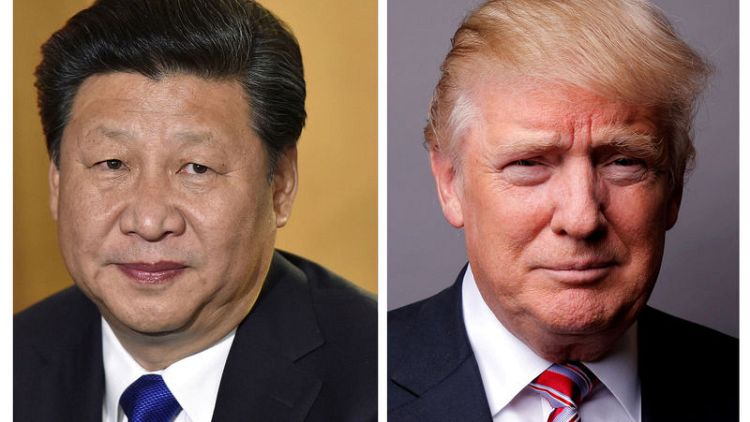By David Brunnstrom and Matt Spetalnick
WASHINGTON (Reuters) - U.S. President Donald Trump and Chinese President Xi Jinping are expected to meet on the sidelines of the G20 summit in Argentina this week for what some see as the most important meeting in years between the leaders of the world's two largest economies.
After months of bitter bickering between their governments over trade and security that has raised questions about the very future of a complex but economically pivotal relationship, the two leaders took a step back from the edge with an ice-breaking telephone call early this month.
They expressed optimism about resolving their damaging trade war ahead of the meeting on Saturday, but there have been few tangible signs of progress. They will be in Buenos Aires for the summit of the leaders of the 20 major economies.
Even so, differences among Trump's top advisers over China policy and his personal unpredictability and fondness for headline-grabbing moments mean it remains anyone's guess what the Trump-Xi meeting might bring.
WHAT CAUSED THE TRADE WAR?
Trump railed against the massive U.S. trade deficit with China during his 2016 election campaign and after a year in office, with no sign of the gap narrowing, the U.S. president attacked the issue head-on. Trump has imposed tariffs on $250 billion worth of Chinese imports to force concessions on a list of demands that would fundamentally change the two countries' terms of trade. China has responded with tariffs of its own on U.S. goods, targeting farm states that are an important part of Trump's political base.
Trump has threatened tariffs on another $267 billion worth of Chinese products, including cell phones, computers, clothing and footwear. And 10 percent tariffs on $200 billion of Chinese goods are scheduled to rise to a more prohibitive 25 percent on Jan. 1, 2019 unless a truce is agreed.
Washington wants Beijing to act to reduce a $375 billion trade surplus by opening its economy to foreign competition, increasing protection for U.S. intellectual property, ending joint venture requirements that lead to technology transfers and cutting subsidies to state-owned industries.
It particularly wants to prevent exports to China of advanced technologies in areas such as artificial intelligence and robotics and has tightened rules on foreign investment in 27 sensitive sectors to stop Chinese deals.
The U.S. Justice Department recently charged China state-owned Fujian Jinhua Integrated Circuit Co with conspiring to steal trade secrets in what is expected to be the first of several similar cases to attempt to stop the flow of intellectual property into China.
U.S. officials say China has delivered a written response to U.S. demands for wide-ranging trade reforms, but they remain doubtful this will be enough to bring about a breakthrough when Xi and Trump meet.
HOW SERIOUS IS THE U.S.-CHINA SECURITY RIVALRY?
In the past 20 years China has grown rapidly to become arguably Washington's biggest security rival, with defence spending that now far outstrips former Cold War rival Russia. A hundred years after the end of World War One, some academics have even warned of another "Thucydides Trap" - a theory that sees a risk of rivalry between a rising and an established power spiralling into open conflict.
Recent years have seen a steady uptick in tensions, punctuated by U.S. naval and air patrols challenging China's extensive claims in the South China Sea and U.S. warship movements through the highly sensitive Taiwan Strait.
While the two sides have taken care to maintain military-to-military contacts, close encounters have raised fears that an accidental clash could escalate into an unexpected conflict - particularly over Taiwan, which Beijing considers a wayward province and a "red line" not to be crossed.
Trump added new uncertainty when he said the United States would quit a Cold-War era treaty with Russia that has prevented Washington from stationing ground-based intermediate-range missiles in Asia as well as Europe.
In what was billed as a major policy speech on Oct. 4, U.S. Vice President Mike Pence escalated Washington's trade-driven pressure campaign, highlighting Chinese military and industrial espionage activity and accusing China of "malign" efforts to undermine Trump in the Nov. 6 mid-term congressional elections. He offered no concrete evidence of that.
IS THE CURRENT TREND REVERSIBLE?
White House insiders say there remain substantial differences within the Trump administration over how far to push China.
This division groups anti-China hardliner and trade adviser Peter Navarro, U.S. Trade Representative Robert Lighthizer and those who favour a complete reevaluation of the relationship on one side. On the other are pragmatists led by White House chief economist Larry Kudlow and Treasury Secretary Steven Mnuchin, concerned about the harm deepening friction could do to the U.S. economy and markets.
In Trump's "America First" rhetoric and persistent criticism of the damaging effect he says Chinese trade practices have on America, he has appeared to favour Navarro's school of thought.
But he has also shown himself very aware of the immediately positive effects any indication of an improved mood with Beijing can have on U.S. financial markets and his ratings for handling of the economy at a time when he is under fire on other domestic fronts.
(Reporting by David Brunnstrom and Matt Spetalnick; Editing by Mary Milliken and Phil Berlowitz)



